Startups all around the world have been using this framework to learn whether they are on a growth track and what specific stages of the funnel need optimization. And investors watched those closely too. For many years, AARRR was the golden standard of metrics until someone proposed to flip the script.
In this article, you will learn:
- Who is the AARRR metrics framework for?
- How does the AARRR metrics framework work?
- How AARRR compares to RARRA
The AARRR framework was devised by investor and entrepreneur Dave McClure (founder of 500 Startups) out of necessity for a simple, universal solution that any startup can use to:
- Develop a model of customer behavior that leads to business growth.
- Improve marketing and development efforts by focusing on metrics that really matter.
Naturally, the pirate association is just a coincidence, stemming from how the metrics are pronounced. It has nothing to do with running a startup like a pirate ship. The goal of using this metrics framework is to create a sustainable and scalable business by leaving all the vanity metrics behind and focusing on what makes a business grow.
Therefore, the pirate metrics are not only for marketers. CEOs, entrepreneurs, product managers, and investors can use them too.
As I mentioned earlier, this framework is often referred to as a type of marketing funnel. This is because acquisition, activation, retention, referral, and revenue are proposed here as subsequent stages of a simplified buyer’s journey.
Potential customers ideally start at the acquisition stage. Some of them are activated through experiencing the product, and only a percentage of those initial visitors will arrive at the revenue stage and become customers.
As in any marketing funnel, the idea is to move people from the first stage to the last. Therefore, these stages become steps you need to take in order to make your business grow. Let’s illustrate that:

So in this section, we’re going to talk about how we can engage each stage of the funnel, plus how to measure each stage of the funnel.
1. Acquisition
Or, in other words, how to attract people to your business? How to make them find your message (or have your message find them) and visit your website or your app? And lastly, how to measure all that?
Without people learning of your existence and coming to you to discover what you offer, your business won’t make any money—no matter how great it is. That’s why you need to think about the marketing tactics and channels that will carry your message to your target audience.
Generally, the more people you attract in the acquisition stage, the more paying customers you will have in the last stage of this funnel.
For this stage, you will likely use a lot of different marketing tactics, spanning various marketing channels. To show you what I mean, let me list a couple of things we do to attract visitors to Ahrefs:
- Product-led articles for our blog
- Product-led videos for our YouTube channel
- Free tools
- Social media
- Partnerships with influencers in our niche
- Advertising on Twitter, Quora, Google Ads, etc
- PR
In choosing your tactics and channels, it’s important to know who your target audience is and where you can reach them.
For example, our target audience consists of people who do SEO: professional SEOs, content marketers, business owners, and bloggers, among others. Knowing what they are interested in and the search demand for those topics, we can decide what content we should create to leverage search demand on Google and finally attract them to our website.
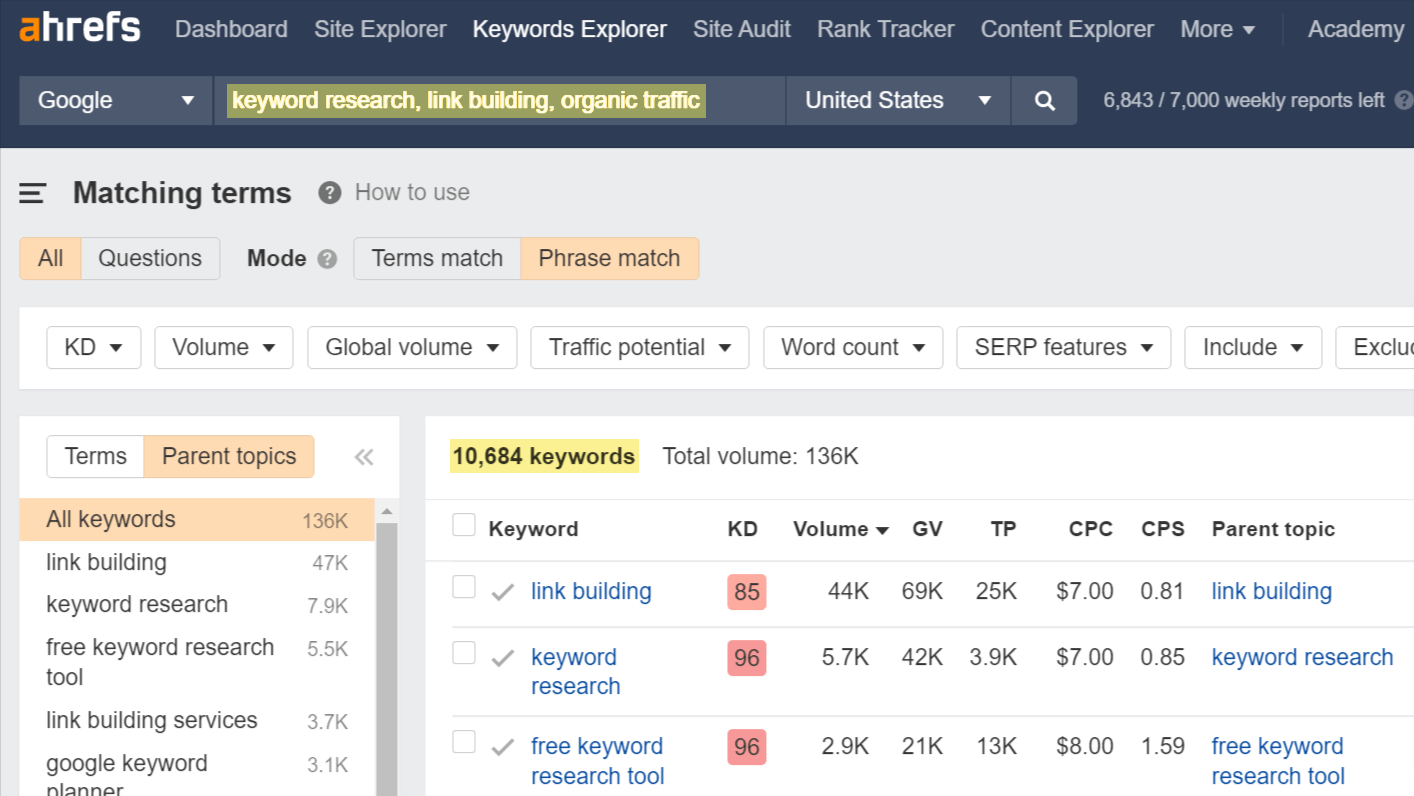
Using a tool like Ahrefs’ Keywords Explorer, you can automatically generate thousands of keyword ideas by just knowing a few topics your target audience is interested in.
This technique is called SEO content: creating content that’s designed to rank on search engines like Google.
Furthermore, we can measure the performance of that content by looking at the organic search traffic:
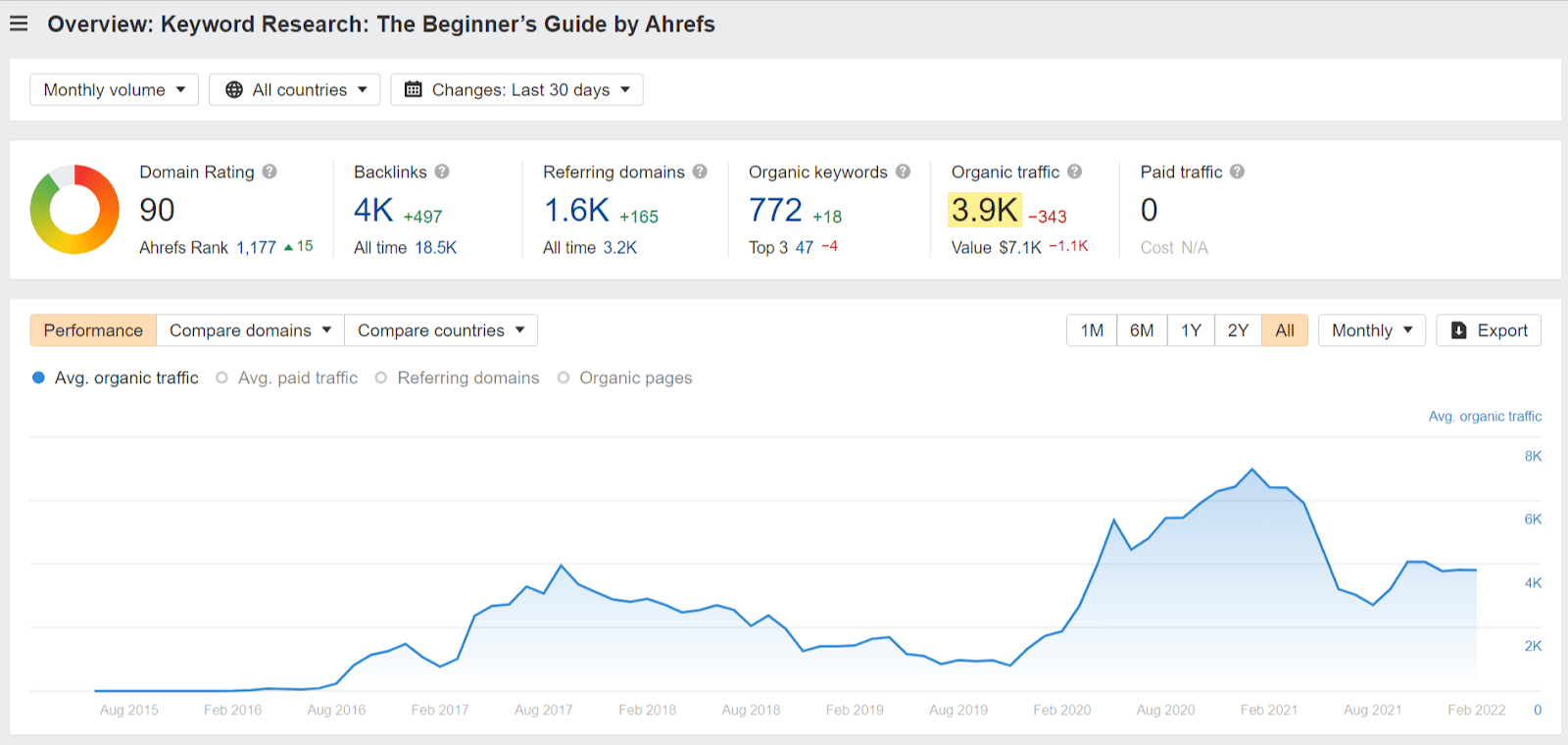
An acquisition metric can be anything that informs you of people coming in from “the outside” to your business. So your metrics for this stage will depend on your channels and your business model. These can be referral traffic from reviews, affiliate links from partners, app store visits, app downloads, and more.

Tracking acquisition is fairly easy in analytics tools like Ahrefs’ Web Analytics. You can get a breakdown of your highest volume and best-performing channels and track specific campaigns, mediums, and sources.
Measuring acquisition doesn’t necessarily mean tracking homepage visits. You can keep track of visits to any landing page/screen that, in your opinion, acts as a gateway to your business—for example, various landing pages used in your PPC campaigns.
Recommended reading: How to Use & Reduce Customer Acquisition Cost (CAC)
2. Activation
The activation stage is about determining, engaging, and measuring the actions you want people to take to experience your product or service. These include signing up for a free trial or a free tool, filling out a contact form, signing up for a newsletter, watching a product demo, etc.
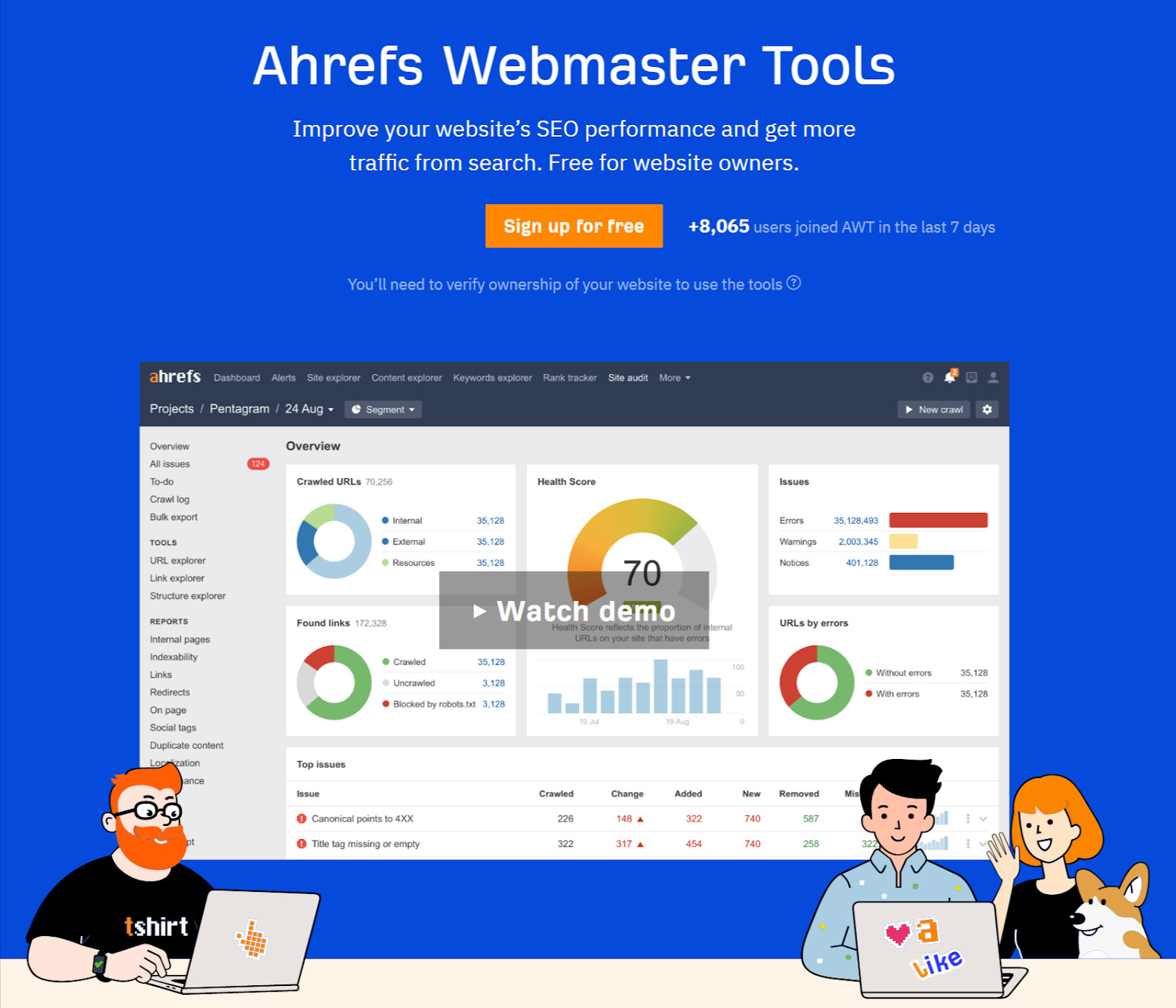
Ahrefs Webmaster Tools is a free SEO tool that we often promote in our content. It’s a great way to activate our visitors because they can use some of the product features for free as long as they want. And if at some point they need more, they have the option to upgrade that same account they’ve been used to.
The reason why you need to “activate” your visitors is that mere visits to your website are not enough to make someone buy from you. Without encouraging your visitors to learn more about or experience your product, they will remain just that—visitors who never become customers.
Of course, it’s nearly impossible to activate 100% of your newly acquired visitors. This study revealed that the average conversion rate on landing pages in the SaaS industry in 2021 was 3%.
Some people will just leave for various reasons (not the right time, just browsing, etc.). This doesn’t necessarily mean you’re doing something wrong. You can precisely target the most relevant keywords, advertise to niche audiences, or be an expert in ad targeting. But you’ll still be visited by people who aren’t ready to buy from you. It’s just part of the game.
Effectiveness in converting people from the acquisition stage to the activation stage depends on factors like:
- How “qualified” are your visitors when they first come to your site? Do they already know your brand? Are they just learning about the solution, or are they ready to make a purchase?
- How compelling is your value proposition?
- How much friction is there before you can activate your visitors? Have you set the bar too high/too low?
- The UX and UI of your website, e.g., aesthetics, site speed, and information architecture.
3. Retention
This part of the AARRR framework is about encouraging activated users to come back.
The idea behind this is if people repeatedly visit your business, it’s a sign that they want more of what you offer—possibly even enough to buy from you. Conversely, if people don’t come back after activation, it’s likely they’ve lost interest in making a purchase.
You can also look at it this way. If you’re activating users through a free trial of your product and your users come back to actually use the product, they are showing a behavioral pattern similar to that of paying customers: coming back multiple times to use the product.
So by encouraging people to come back, you are fostering that behavioral change. And by measuring this stage, you can more easily forecast which users/cohorts are likely to become customers.
Here are some factors that can influence this stage of the funnel:
- Expectations vs. reality – If you’re overpromising in the previous stages of the funnel and underdelivering here, people will drop off massively.
- Low value for the money – Sometimes, there is no other way to see if something is worth the money until you try it. In some cases, people find the value of their purchase doesn’t match the money they spent.
- Product education – If people don’t know how to use your product or where to find certain features, they will feel confused or even frustrated.
- Lack of a use case – It’s one thing to show people how they can do something or where they can find some function, and it’s another to inspire. Your customers may need a product like yours, but they may not know what to use it for or how to fit it into their workflow.
- Tire-kickers and hitchhikers – Some people whom you have successfully activated never meant to buy your product. Some people may just want to browse around, and that’s it. Others may sign up for that one particular thing you offered in your free trial without the need to use it regularly.
With some theory out of the way, let’s look at an example of influencing the retention stage.
At Ahrefs, we use product education as a way to keep our users informed and engaged. So when people sign up for an Ahrefs account, we send them three onboarding emails with an overview video of our toolset and some tips on how to get around the interface.
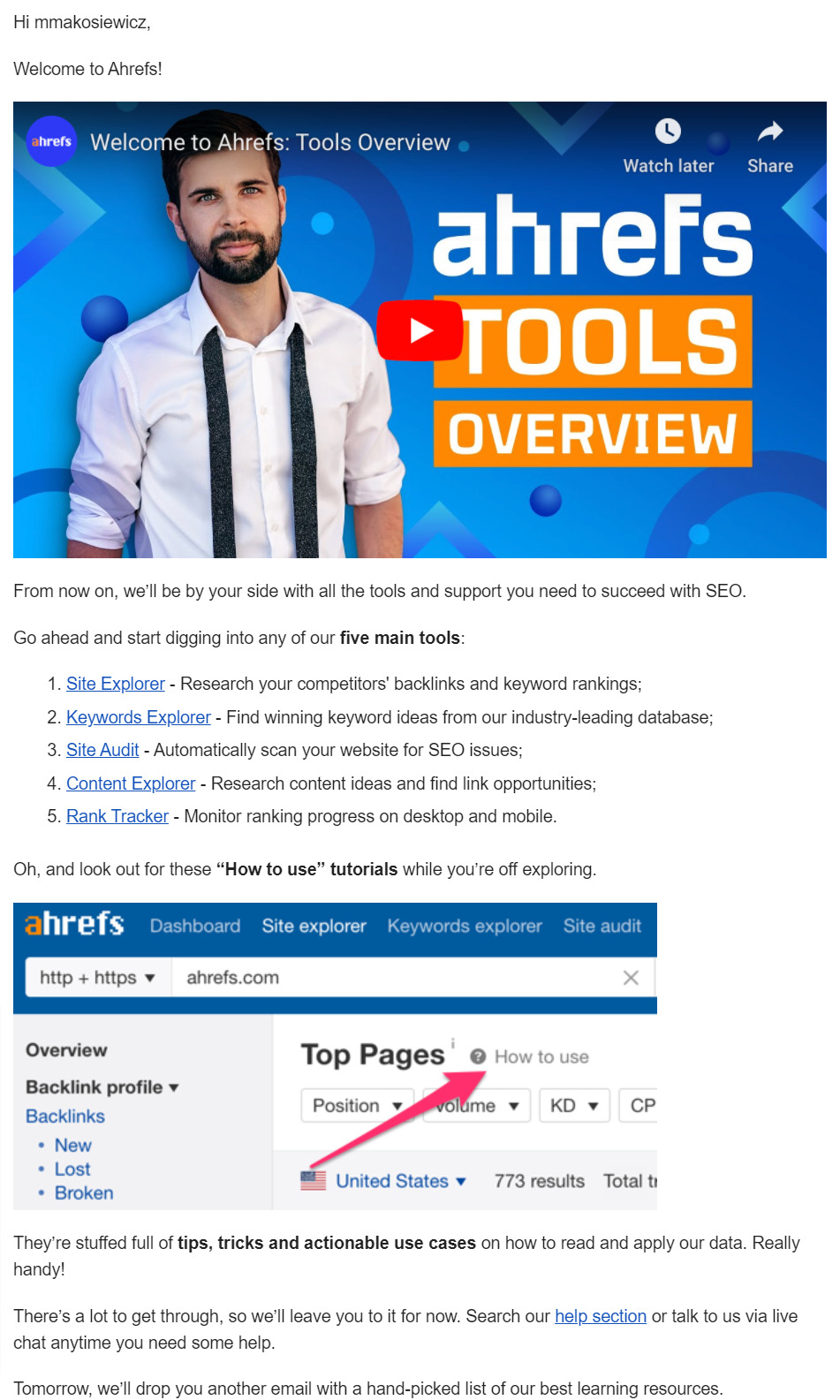
It’s a good way to deliver product education in your first email because people actually expect those. (On average, welcome emails get a 91.43% open rate.)
Essentially, that email provides a shortcut to all the product education we serve in other places: this blog, Ahrefs Academy, Ahrefs Insider group on Facebook, and educational videos on YouTube.
As you may have noticed in the screenshot above, we also provide support contextually right inside the product. Every metric that users find inside the toolset has a hint explaining what it is for, and all reports are accompanied by tutorials.
When it comes to measuring retention, the best way to do it is by measuring product engagement (of course, if you’re offering some kind of free trial). For example, you can track how many users log in at least three times in a seven-day period. (You can use tools like Mixpanel or Heap.)
On a side note, if you discover a unique pattern of product usage among your paying customers, you can later use that to modify your retention metrics to better identify users who are most likely to upgrade their accounts.
If you’re not offering a direct product experience in the activation stage, you can reach for other metrics like:
- Repeated visits to your website (or certain pages in it).
- Newsletters being opened.
- A continued conversation with your sales team.
In fact, in this talk about the pirate metrics, Dave says that “people bounce off your site because they didn’t mean to come there. … Those aren’t the folks that you’re really looking at.”
This isn’t entirely accurate.
First of all, the “bounce rate” metric most often paints a skewed picture of user engagement. That’s why it has been quite recently replaced in Google Analytics 4 by another more universal and more “sensitive” metric.
Second, it may take several touchpoints for a new user to be interested in your product.
So despite the original theory, you may want to consider tactics that will encourage your inactivated users to come back, e.g., retargeting, blogging, being active on social media.
4. Referral
The referral stage in your AARRR metrics should answer the question, “How do we know people like us enough to recommend us, and how can we influence that?”
Referral is just one of the many acquisition channels. However, when someone likes your product enough to tell others, that can’t be a better sign that you’ve created something of great value and people are ready to pay for it. In startup lingo, this means you’re getting traction.
Another reason why you need to take user recommendations seriously is it’s one of the most effective ways to acquire new customers. According to a Nielsen study, 83% of people trust recommendations from friends and family, and 66% of people trust consumer opinions posted online.
As a result of referrals from your happy users, you get more prospects to “fuel” the acquisition stage of the funnel (hence the arrow pointing from referral to acquisition in our illustration of this framework).
But how to make users recommend your product to others? Well, there is no other way around it than to build something truly valuable and provide a great user experience. How? Start with researching your market to understand what the market needs and how well the competition serves that demand. Next, make sure your business idea can achieve product-market fit.
You can look for signs of positive (and negative) word of mouth about your product or service in:
- Social media shares and conversations.
- Industry surveys.
- Review sites.
- Communities in your market segment.
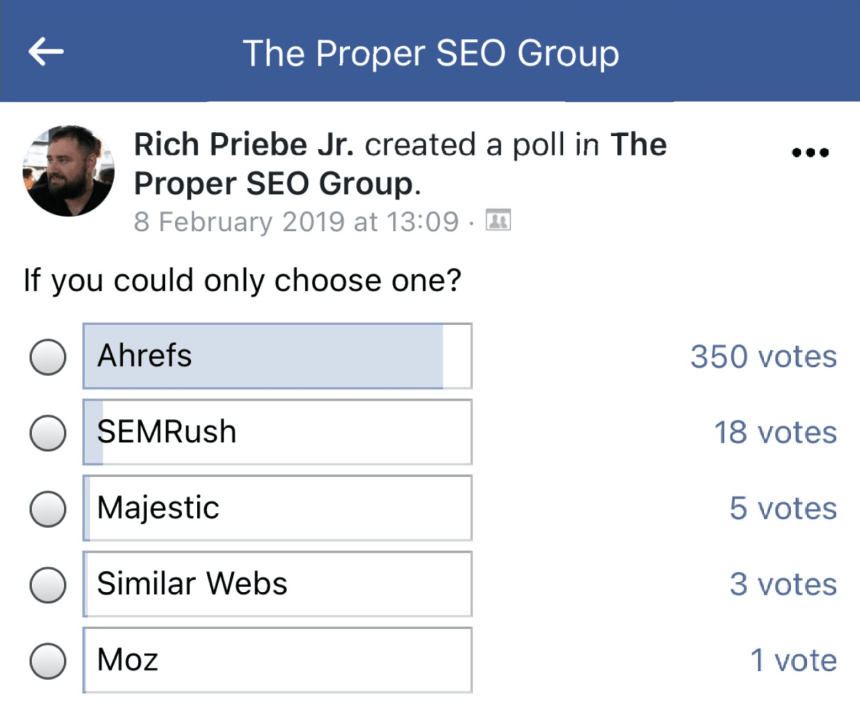
Receiving positive word of mouth organically is the absolute foundation. But not all of your users will be willing to share their experiences, and that’s completely normal. But there are some ways you can influence word of mouth to give it an additional push:
- Referral programs
- PR
- Helpful content that solves your users’ problems
- Encouraging users to share their experiences on review sites like G2 or Capterra
- User-generated content (e.g., pictures with branded hashtags on Instagram)
- Positive experiences (e.g., sending users free swag)
- Social sharing widgets
When it comes to measuring this stage of AARRR, one idea is to use social media tools like Brand24 to monitor the web for mentions of your product/brand. You can also keep track of your reviews and look for any significant changes in the average rating scores.
If you want to go even deeper and measure the referral stage more thoroughly, you can gauge how willing people are to recommend you using the NPS score.
5. Revenue
And finally, after your visitors become activated users, some of them become paying customers.
A somewhat more technical term for that is “monetization behavior.” Dave advises startups to figure out what part of their product or service should be monetized.
For example, the more you use Ahrefs, the more you pay for it. But you don’t pay for every click you make. This is a poor monetization behavior idea. For us, it makes the most sense to tie the price of our service to certain tiers of data usage and data update frequency.

Different data usage for different pricing tiers.
In practice, as the usage of our product grows, so do our costs. But our profit grows proportionally as well.
Of course, monetization behavior for your business can be something completely different. You may even keep your service completely free for users and monetize via ads or in-app purchases (e.g., social media platforms).
When it comes to influencing your revenue, you may have already guessed that revenue is an outcome of all of the previous stages of the funnel. The more visitors you attract and effectively activate, the more sales you get in the end.
Let me give you an example. The more we educate people with product-led content, the more data people use in their accounts. And since that’s the main driver of revenue for us, the more data people use, the more we profit. And it’s a win-win. If people use more data, it means they know how to put our product into practice to improve their SEO.

One of the many articles that explain how to solve SEO and marketing problems using Ahrefs.
As for measuring this last stage of the framework, here are some popular revenue metrics:
- Customer lifetime value (CLV or CLTV)
- Annual or monthly recurring revenue (ARR, MRR)
- Revenue growth rate
Let’s conclude this section with Dave’s original AARRR dashboard example.
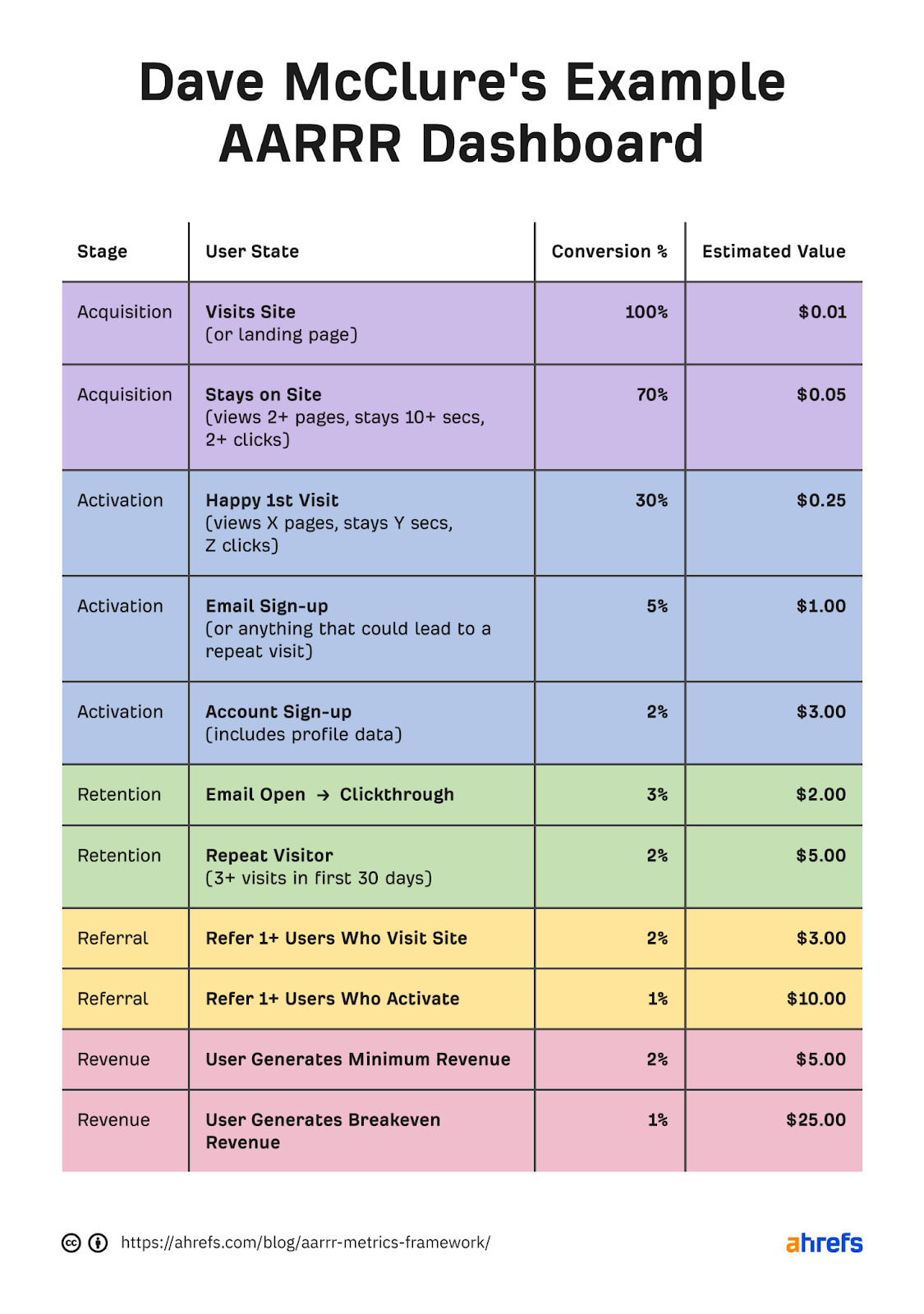
A few takeaways from the picture above I’d like to note:
- Notice how conversion drops as you go down the framework. That’s normal. All marketing funnels are leaky by design. (They probably shouldn’t be called “funnels” in the first place.) But don’t treat those numbers as benchmarks, as they are just examples.
- Notice that there are multiple micro stages at each stage. For example, activation consists of these: happy 1st visit, email sign-up, and account sign-up. But you don’t have to frame it this way. You can simplify this dashboard using just one metric per stage. You can also go deeper and use a more granular way of measuring (learn more about marketing KPIs here).
If I haven’t stressed the importance of retention enough, here is an alternative metrics framework that is literally based on this stage.
RARRA is the pirate metrics “remixed” by Thomas Petit and Gabor Papp with mobile startups in mind (but could probably be used by any startup). It goes like this:
- Retention – Focus on creating a product that people will want to come back to
- Activation – Let people experience the value of your product (aka the “aha moment”) as soon as possible
- Referral – Get your users to talk about the app and share it
- Revenue – Find ways to monetize the product
- Acquisition – Scale and optimize your acquisition channels; do it only after you have clear signals that people are willing to come back to your app (important!)
As you can see, this framework consists of the same stages that we’ve discussed so far. So the question arises, “How is RARRA different from AARRR?”
In my opinion, the main difference between these two frameworks is that RARRA emphasizes certain metrics, while AARRR is just a model for identifying the critical stages in a buyer’s journey.
Or let’s put it this way. The AARRR framework is simply proposing that activation is the first stage in a buyer’s journey. But reading the RARRA framework the same way is wrong because retention can’t be the first stage in a buyer’s journey.
The remixed framework leads with retention (instead of activation) because it tries to emphasize that mobile startups should build products with retention in mind. The original framework, on the other hand, doesn’t specify that you need to focus more on one stage than the other.
I’d say that RARRA is a good commentary to AARRR that’s made 10 years later. And weirdly enough, you can use both. You should build easy-to-use, valuable products that users will want to come back to, but you should also figure out how to attract those users. And what’s more, you will need to acquire a lot more users at the top of the funnel than you want to have customers at the bottom of the funnel.
Of course, I fully encourage you to develop your own opinion about these two frameworks. Or even develop your own modifications when you’re ready. For more information on RARRA, start with Why Focusing Too Much on Acquisition Will Kill Your Mobile Startup.
Final thoughts
One of the most accurate definitions of a startup comes from Eric Ries: “A human institution designed to bring something new under conditions of extreme uncertainty.” That element of uncertainty is what makes focusing on the right things absolutely critical for startup success.
And this is what AARRR offers: focusing on the metrics that really matter to build a sustainable business. This framework may not be complete or perfect, as RARRA proponents claim. But it’s a really good start if you use it properly.
As you go along and learn how to build and market a startup, you’ll see a lot of the-only-thing-that-matters type of stuff. Take all that with a grain of salt. I believe you should try things yourself and see where they take you.
Got questions or comments? Ping me on Twitter.




